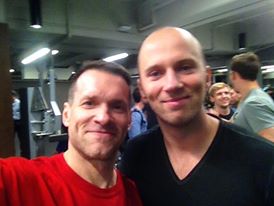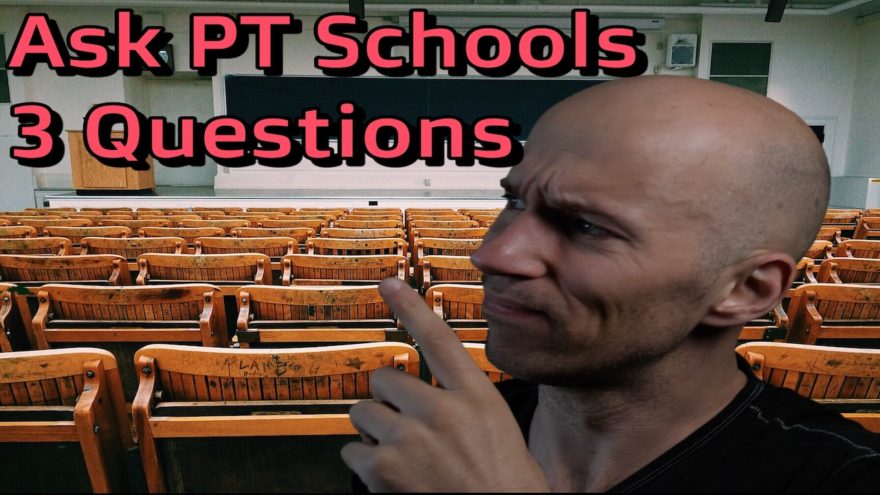Table of Contents
Questions to ask PT school that will actually impact your career
When applying for anything, especially PT school, it’s common and expected to ask the school important questions. This shows that you are vested in the process.
The problem is that most of the questions people on the internet tell you to ask are IRRELEVANT to moving forward in your career. Like how to pass the licensure, what separates you from other schools, etc.
Although the PT school application process is nerve-wracking, never forget that YOU are also interviewing THEM.
You have to make sure this school is the best fit for you and will set you up for success for the rest of your career.
How will you know that? Check out today’s post below to learn more!
How much does it cost?
The cost of physical therapy school is the single most important factor in deciding which school to attend.
Consider this, according to US News, the average physical therapist made around $89,000 per year in 2019, with a fairly large variance depending on where you live, how long you’ve been practice, and what setting you work in. For example, it’s fairly common for home health, skilled nursing, and travel PT to be the top earners, whereas outpatient doesn’t pay as well. The growth in this field is also expected to be around 18% in the next 10 years.
Conversely, look at how much student debt the average physical therapist will have once out of school according to the APTA – $116,183!
According to this article, a general rule of thumb is that your total student loan debt should be less than your annual income, which would mean your repayment ratio ought to be around 10-15% of your income.
If you assume about a 5% interest rate on this amount to be paid over 10 years and that you’ll make the average $89k salary your first year out of PT school (LOL, unlikely big fam), 17% of your income is going to go toward student loans.
That may not seem like much, but also consider if you have 25% of your income going to housing, the amount of money you have to live life, save for retirement, and build equity slowly dwindles. Moreover, the more debt you have, the harder it’ll be to get good interest rates on things like homes, cars, etc.

Contrast this with a profession like a physician assistant. According to the Bureau of Labor Statistics, their average salary is $115,390 as of 2020. Whereas their average student loan debt is around $112,500. Again, not perfect, but significantly less compared to what a typical PA will make.
Not only that, but with reimbursement rates continuing to decline, as well as physical therapy schools increasing the number of students enrolling into programs, the odds of salaries significantly increasing is low, and the risk of market saturation is quite high.
To be successful as a physical therapist, you’ll need to stand out by educating yourself and finding great mentorship to help you along the way. If you are crippled with student loan debt, your ability to do both of these things will be sorely limited.
Going hard on education and having excellent mentorship was essential in taking my career to where it is today, but the downside was my debt increased significantly because I wasn’t tackling my student loans. Unwise AF, as I had to force myself to work a ridiculous amount on the backend to finally eradicate those damn loans!
You have to take the costs of PT school seriously, and you’ll want to keep them as low as possible.
Ask the school about pricing, scholarships, employment opportunities, anything you can to cut costs. It was the biggest mistake that I made in the process.
The paper degree is the same no matter where you go, so choose the lowest price tag possible, making sure that your debt amount is significantly less than what you’ll expect to earn.
Can I set up my own clinicals?
As much as you learn when you are in class, the most important learning experience that will carry over to your job are your clinicals. Getting in the trenches with those supreme clientele so-to-speak.
Nothing will prepare you better for patient care than seeing patients under the guidance of an excellent clinical instructor (CI). The CI will help you use their experiences, successes, and failures, to shape your clinical practice the way you desire it to be.
I cannot harp on this point enough, you want to have the best CI you possibly can! Someone who has a set up the way you want to practice.
Having Bill Hartman as my CI was one of the most transformative experiences of my career. I wouldn’t be ⅓ of the PT I am today if I didn’t have this experience. Not just from a practice standpoint, but the connections I’ve made, the friendships I’ve made=, everything. I wanted to work like Bill does, and that’s why I reached out to him. In fact, I thought setting up clinicals with who you want to work with was a normal thing.

But did you know that a lot of PT schools won’t let you set up your own clinical experiences?
I’ve had several colleagues who went into PT school thinking they could have all these great clinical experiences with their heroes, only to have the PT school say no. Telling the student that we have all these great clinical sites already set up for you, choose one of them. Sadly, many of the choices were grim, getting into patient mills or having lackluster instructors. YIKES!
Having excellent clinical affiliations is so important for sending you down a successful career path that you cannot leave these experiences to chance. I would strongly encourage you before attending PT school to do the following:
- Really think about the practice setting you want to be in
- Reflect on the type of clinician you want to be
- Seek out physical therapists who embody the first two points and have a set up you desire
- Reach out to those PTs to see if they accept students
- Have this information ready at your PT school interviews
If the school you are interviewing for says that you cannot set up your own clinical experiences, run away as fast as possible!
Does your curriculum best support my goals?
While excellent clinical experiences are the most important, you do want to have a solid curriculum that will support you getting the most out of those experiences.
But the topics that’ll support you best aren’t what you think.
Like it or not, the practice strategies and treatments taught in PT school are often a bit antiquated. The exercise selection is LOL status, manual therapy is hit-or-miss (mine was pretty good though actually), and don’t even get me started on modalities, fam!

To me, the treatments you learn in school aren’t all that important. That’s what the clinical are for! (You asked the last question, right?)
What is important, however, are the basic sciences.
The basic sciences, fam. I’m talking anatomy, physiology, kinesiology, chemistry, physics, etc. These courses provide the fundamentals needed to be an excellent physical therapist. They are like the bounce pass of PTs.
Having a thorough understanding of basic sciences will allow you to:
- Better consume research and continuing education
- Critically appraise different thought processes
- Devise treatment strategies that have a scientific underpinning
Although my basic sciences were pretty solid at my school, I didn’t study them to the extent I should have. That’s why my current studies focus a lot on reviewing the fundamentals.
Having a good basic science background will help set you up for major success.
Once you have that out of the way and you know what practice setting you want to work in, choose a program that has a curriculum that provides experiences in that domain. If you want to research PT things, do you have a big research project you need to complete? Want to get into neuro? Will you get to observe different neuro cases and learn from a rockstar neuro professor? Thinking outpatient is your gig, teach me as much manual as possible big fam!
Don’t hesitate to ask those interviewing you how their curriculum will best help you be the PT you want to be.
Sum up
- Know the cost of PT school, and make it as cheap as possible
- If you can’t set up your own clinicals, run far far away from that school
- Emphasize basic sciences and then anything else that may help you along your career path
Photo credit
Image by Wokandapix from Pixabay
Song credits
Cherry Metal by Arthur Vyncke | https://soundcloud.com/arthurvost
Creative Commons Attribution-ShareAlike 3.0 Unported
https://creativecommons.org/licenses/by-sa/3.0/deed.en_US
Music promoted by https://www.chosic.com/free-music/all/
Still Awake by Ghostrifter Official | https://soundcloud.com/ghostrifter-official
Music promoted by https://www.chosic.com/free-music/all/
Creative Commons CC BY-SA 3.0
https://creativecommons.org/licenses/by-sa/3.0/
Merry Bay by Ghostrifter Official | https://soundcloud.com/ghostrifter-official
Music promoted by https://www.chosic.com/free-music/all/
Creative Commons CC BY-SA 3.0
https://creativecommons.org/licenses/by-sa/3.0/
Hot Coffee by Ghostrifter Official | https://soundcloud.com/ghostrifter-official
Music promoted by https://www.chosic.com/free-music/all/
Creative Commons Attribution-ShareAlike 3.0 Unported
https://creativecommons.org/licenses/by-sa/3.0/deed.en_US
On My Way by Ghostrifter Official | https://soundcloud.com/ghostrifter-official
Music promoted by https://www.chosic.com/free-music/all/
Creative Commons CC BY-SA 3.0
https://creativecommons.org/licenses/by-sa/3.0/
Music: https://www.chosic.com/free-music/all/

Lol now I see what I said about regular classes not being that important was a fallacy. I get it but of course I am not the most patient person and I want to just do the limited perspective manual therapy work. These are great questions to ask about setting up your own clinicals. I don’t need to let my fear of learning, failure and Grade point average keep me from having the most solid foundations possible to be a better PT. Great article!
You gotta be able to throw the bounce pass before the behind-the-back 😉
Keep kickin’ ass!